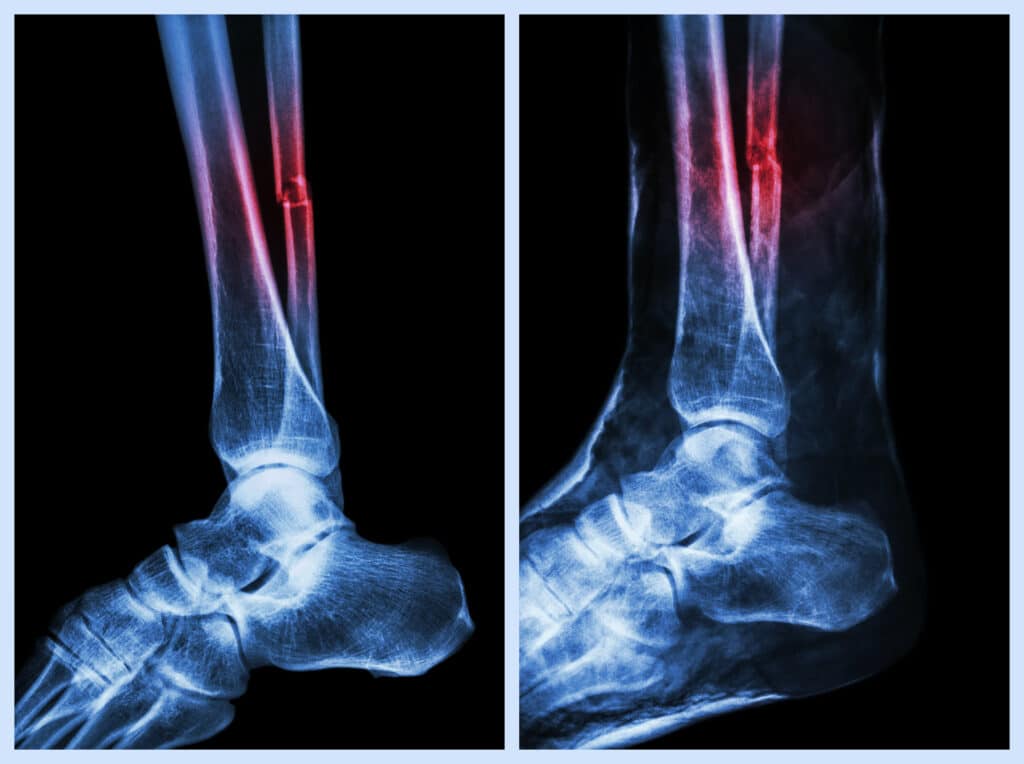Fibula Fracture: Types & Treatment
You may recall from high school anatomy that you have two long bones in your lower leg: the tibia and the fibula. A fibula fracture is when you break the thinner of those bones that runs along the outside of your leg, the fibula.
You can suffer a fibula fracture from a forceful impact, a sports injury, or even a sprained ankle. Depending on the severity of the break, you may need a cast and time to heal, or you could require surgery.
Fractured Fibula

The fibula, sometimes called the calf bone, joins the larger of the leg bones, the tibia (shin bone), at the knee and ankle joints. It is not considered a weight-bearing bone. Its main function is to provide stability and support to the ankle joint.
A fracture of the fibula can occur in any part of the bone. A distal fibula fracture, which occurs at the ankle end, is sometimes classified as an ankle fracture. Common causes of a fractured fibula include rolling your ankle, a fall or awkward landing, or a direct blow to the leg or ankle.
A fibula fracture can run in virtually any direction and vary in severity. Common types of fibular fractures include:
- Lateral malleolus fractures—fractures at the ankle; these breaks are sometimes classified as ankle fractures even though the break is on the fibula
- Fibular head fractures—a fibular head fracture occurs at the knee; may also be called a proximal fibula fracture
- Avulsion fracture—avulsion fractures are those where a small piece of bone attached to a tendon or ligament breaks away from the main part of the bone
- Fibula stress fracture—stress fractures are incomplete cracks caused by repetitive stress
- Fibular shaft fracture—a fracture in the midsection of the bone, typically caused by a direct blow to that area
Signs of a Fibula Fracture
The most common symptoms of a fibula bone fracture are pain and swelling. Other possible signs of a fibula fracture include:
- Tenderness to the touch
- Bleeding and bruising
- Inability to put weight on that leg
- Obvious deformity
- A numb or cold foot (this may also occur with a foot fracture)
Many fibula fractures happen as part of an ankle injury. They may look and feel like a badly sprained ankle. However, since they can be more serious, it’s important to see an orthopedic specialist for a proper diagnosis.
Diagnosing a Fibular Fracture
If you’ve hurt your leg and have any of the symptoms above, it’s a good idea to see your ankle specialist for a diagnosis. They will perform a physical examination and take an X-ray. It’s possible they’ll need you to get an MRI so they can get more detailed images of the bones and soft tissues. In some cases, you’ll also need a bone scan, CT scan, or other tests to determine the severity of your fracture.
Fibula Fracture Treatment

Fibula fracture treatment depends on the location, severity, and type of fracture. Treatment options differ if the fracture is open (compound) or closed (simple). Fibula fractures with associated ankle injuries often require surgery.
Stress fractures are less serious fibula fractures and typically do not require surgery. They are small hairline cracks or breaks that usually develop over time. A fibula stress fracture may become worse with exercise and ease off when you give it rest. Your doctor may recommend treating this type of break with rest, elevation, and possibly a cast, brace, or boot.
Open Fracture
Also called a compound fracture, an open fracture occurs when the bone either pokes through the skin or the skin is wounded enough to expose the bone.
Most open fibula fractures result from high-impact traumas or direct blows, such as falls or motor vehicle accidents. They may also happen due to high-energy twisting injuries during sports or other recreational activities.
Compound or open fractures are serious injuries, and they require immediate medical attention. Compound fractures usually involve additional issues that require treatment. You’ll be given antibiotics to avoid infection and may also get a tetanus shot. Your wound will need thorough cleaning and probably surgery.
One common type of surgery for a fibula fracture is an open reduction. In this procedure, your ankle surgeon will realign your bones in their normal position, holding them in place using plates, screws, or rods. They may use internal hardware (internal fixation) or place screws or pins outside the skin (external fixation).
Closed Fracture
Also called a simple fracture, closed fractures are those where the skin remains intact, covering the bone. Closed fractures may or may not require surgery. If nothing other than your fibula is damaged, a splint or cast may be enough support to help you heal.
When treating a closed or simple fracture, your orthopedic specialist may be able to realign your bones using a closed reduction. In a closed reduction, your specialist sets the bones without cutting open the skin. You’ll likely get a cast or wear a splint after the procedure. You’ll likely need prescription or over-the-counter pain medications at first, as well as crutches.
Tibia-Fibula Fracture
Breaking the fibula alone isn’t nearly as common as breaking it with additional damage to surrounding ligaments or in conjunction with the tibia. When both the tibia and fibula fracture, it’s generally called a tibia-fibula fracture.
Symptoms of a fractured tibia fibula are similar to those of a fibula fracture, though it’s more likely you will not be able to stand or walk if both bones are broken. Treating a fracture of the tibia fibula is similar to treating a fibula fracture, as it’s highly dependent on the location, complexity, and severity of the break or breaks.
Fractured Fibula Recovery Time

Fibula fracture healing time depends on the complexity of the break and how quickly you get treatment. Generally speaking, it can take a few weeks to several months. If you need surgery or your fibula was displaced, it may be around 6 months before your pain and swelling resolve.
Your orthopedic specialist may recommend physical therapy to help heal and restore range of motion. You’ll also want to keep your leg elevated as much as possible to help with the pain and swelling. Generally speaking, most fibula fractures heal without long-term complications.
If you have leg or ankle pain and would like to speak with a specialist, please contact us or comment below.
Leave a Reply